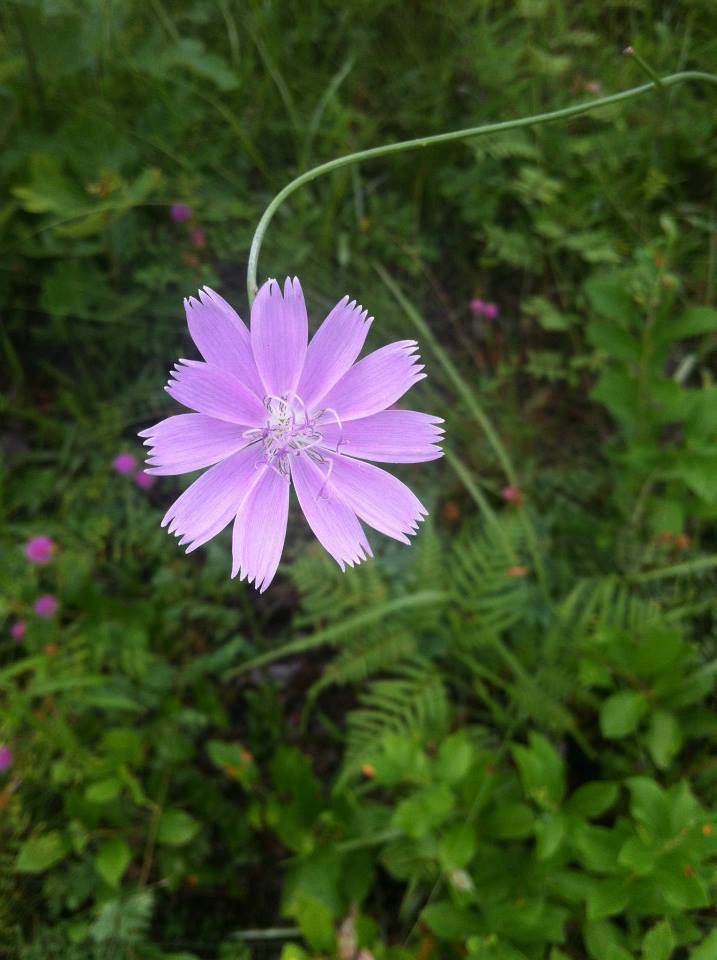Difference between revisions of "Lygodesmia aphylla"
| Line 25: | Line 25: | ||
===Habitat=== <!--Natural communities, human disturbed habitats, topography, hydrology, soils, light, fire regime requirements for removal of competition, etc.--> | ===Habitat=== <!--Natural communities, human disturbed habitats, topography, hydrology, soils, light, fire regime requirements for removal of competition, etc.--> | ||
It is found in Florida scrub community (Archbold Biological Station)(Deyrup et al 2002). | It is found in Florida scrub community (Archbold Biological Station)(Deyrup et al 2002). | ||
| + | |||
| + | This species has been found in sandhills, scrub habitats, pine flatwoods, pine-wiregrass savannas, and mixed woodlands (FSU Herbarium). It has been observed in open areas in dry, deep, moist-peaty, and loose sands as well as in gravelly soils (FSU Herbarium). This species also occurs in human disturbed areas such as clobbered scrub oak habitats, bulldozed areas, orange groves, along roadsides, along old fields, cut-over pinelands, fallow fields, spoil banks, and parks (FSU Herbarium). | ||
===Phenology=== <!--Timing off flowering, fruiting, seed dispersal, and environmental triggers. Cite PanFlora website if appropriate: http://www.gilnelson.com/PanFlora/ --> | ===Phenology=== <!--Timing off flowering, fruiting, seed dispersal, and environmental triggers. Cite PanFlora website if appropriate: http://www.gilnelson.com/PanFlora/ --> | ||
Revision as of 14:33, 20 July 2015
| Lygodesmia aphylla | |
|---|---|

| |
| Photo taken by Michelle M. Smith | |
| Scientific classification | |
| Kingdom: | Plantae |
| Division: | Magnoliophyta - Flowering plants |
| Class: | Magnoliopsida – Dicotyledons |
| Order: | Asterales |
| Family: | Asteraceae ⁄ Compositae |
| Genus: | Lygodesmia |
| Species: | L. aphylla |
| Binomial name | |
| Lygodesmia aphylla (Nutt.) DC. | |

| |
| Natural range of Lygodesmia aphylla from USDA NRCS Plants Database. | |
Contents
Description
Common name: rose rush
Distribution
Ecology
Habitat
It is found in Florida scrub community (Archbold Biological Station)(Deyrup et al 2002).
This species has been found in sandhills, scrub habitats, pine flatwoods, pine-wiregrass savannas, and mixed woodlands (FSU Herbarium). It has been observed in open areas in dry, deep, moist-peaty, and loose sands as well as in gravelly soils (FSU Herbarium). This species also occurs in human disturbed areas such as clobbered scrub oak habitats, bulldozed areas, orange groves, along roadsides, along old fields, cut-over pinelands, fallow fields, spoil banks, and parks (FSU Herbarium).
Phenology
Seed dispersal
Seed bank and germination
Fire ecology
Pollination
Mark Deyrup at Archbold Biological Station observed these Hymenoptera species on Lygodesmia aphylla:
Halictidae: Augochlorella aurata
Use by animals
Deyrup observed this bee, Augochlorella aurata, on L. aphylla (Deyrup et al 2002). Fire ants are not interested in the seeds of L. aphylla (Cumberland et al. 2013).
Diseases and parasites
Conservation and Management
Cultivation and restoration
Photo Gallery
References and notes
Cumberland, M. S. and L. K. Kirkman (2013). "The effects of the red imported fire ant on seed fate in the longleaf pine ecosystem." Plant Ecology 214: 717-724.
Deyrup, M. J. E., and Beth Norden (2002). "The diversity and floral hosts of bees at the Archbold Biological Station, Florida (Hymenoptera: Apoidea)." Insecta mundi 16(1-3)